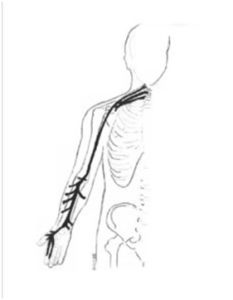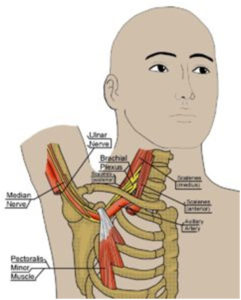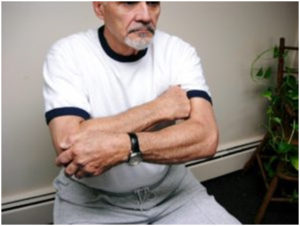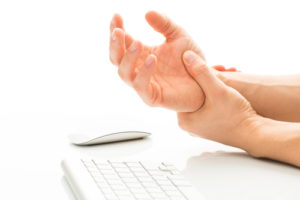The Symptoms of Carpal Tunnel Syndrome Are Caused By Tight Muscles
Author: Julie Donnelly, LMT –The Pain Relief Expert
Editor: Dr. Steve Chaney
In 1997 I was diagnosed with carpal tunnel syndrome: wrist pain, tingling and numb fingers. The pain and burning was horrible, it prevented me from even picking up a pencil or holding a glass. As a massage therapist it was devastating, my hands are my livelihood! I tried everything and finally had to close down my therapy practice because the pain was so severe. I knew I wasn’t going to go for surgery, but carpal tunnel syndrome was a hurdle that was pushing me out of work and I didn’t know where to turn.
Finally, I started to think of the logic of the body. While everyone was looking at my wrist and forearm, the median nerve that causes the symptoms of carpal tunnel syndrome doesn’t start in my arm, but where does it start? Research showed that the nerve actually starts in your NECK! Who would have thought this would be what causes carpal tunnel!
I found the solution to my problem, and I’ve been bringing it to people worldwide ever since.
How Muscles in Your Neck Can Be What Causes Carpal Tunnel Syndrome Symptoms
 A bundle of nerves called the Brachial Plexus (see three lines in neck of drawing) comes out of your cervical vertebrae and at the top of your shoulder the fibers divide into three nerves:
A bundle of nerves called the Brachial Plexus (see three lines in neck of drawing) comes out of your cervical vertebrae and at the top of your shoulder the fibers divide into three nerves:
- The Median Nerve – which goes to your thumb and first two fingers
- The Ulnar Nerve – which goes to your ring and pinky fingers
- The Radial Nerve – which goes to your wrist
Your Scalenes muscle is in front of, and in back of the brachial plexus.
When the scalenes are in spasm, they put pressure on the bundle of nerves and it can cause tingling and numbness to be felt all the way to your fingers. The purple shading shows the referred pain pattern for the scalenes spasms. This can be what causes carpal tunnel and in my case this was the primary cause of the carpal tunnel syndrome symptoms I had in my thumb and first two fingers.
By the way, your scalenes also cause that burning feeling you get between your shoulder blades. You are rubbing your back, but the cause of the pain is actually in your neck!
How Muscles in Your Chest and Upper Arm Can Cause the Symptoms of Carpal Tunnel Syndrome
 The bundle of nerves goes along the front of your body and at the top of your shoulder it breaks into the three nerves (listed above) and they go under a bone called the coracoid process (a part of your scapula/shoulder blade).
The bundle of nerves goes along the front of your body and at the top of your shoulder it breaks into the three nerves (listed above) and they go under a bone called the coracoid process (a part of your scapula/shoulder blade).
There are three muscles that attach to your coracoid process, (the biceps , pectoralis minor , and the coracobrachialis ). When any of them are in spasm, they will pull the bone down onto the three nerves causing tingling and numbness to radiate down your arm and into your wrist &/or hand. This is one of the symptoms of carpal tunnel syndrome, yet most medical practitioners don’t consider these muscles when searching for the cause of numbness in your fingers.
Treatment for Carpal Tunnel Syndrome
A Julstro Self-Treatment That Releases Tension in Your Shoulder and Off the Nerves to Your Hand
 You can self-treat your upper arm muscles that are putting pressure on the coracoid AND also on your shoulder joint.
You can self-treat your upper arm muscles that are putting pressure on the coracoid AND also on your shoulder joint.
Simply make a fist and press into your biceps, using your opposite hand to help push your elbow so you can go deeper into your biceps.
Hold the pressure for 15-30 seconds and then continue the pressure while you S-L-O-W-L-Y open your arm. Release the pressure, bend your arm, and repeat 2-3 times
End of Part 1 –
Next month I will show the muscles of your lower arm and hand and why they can be what causes carpal tunnel syndrome symptoms. Plus, you’ll get a self-treatment that is great for taking the pressure off your carpal tunnel.
Wishing you well,
Julie Donnelly
About The Author
Julie Donnelly is a Deep Muscle Massage Therapist with 20 years of experience specializing in the treatment of chronic joint pain and sports injuries. She has worked extensively with elite athletes and patients who have been unsuccessful at finding relief through the more conventional therapies.
She has been widely published, both on – and off – line, in magazines, newsletters, and newspapers around the country. She is also often chosen to speak at national conventions, medical schools, and health facilities nationwide.
These statements have not been evaluated by the Food and Drug Administration. This information is not intended to diagnose, treat, cure or prevent any disease.

